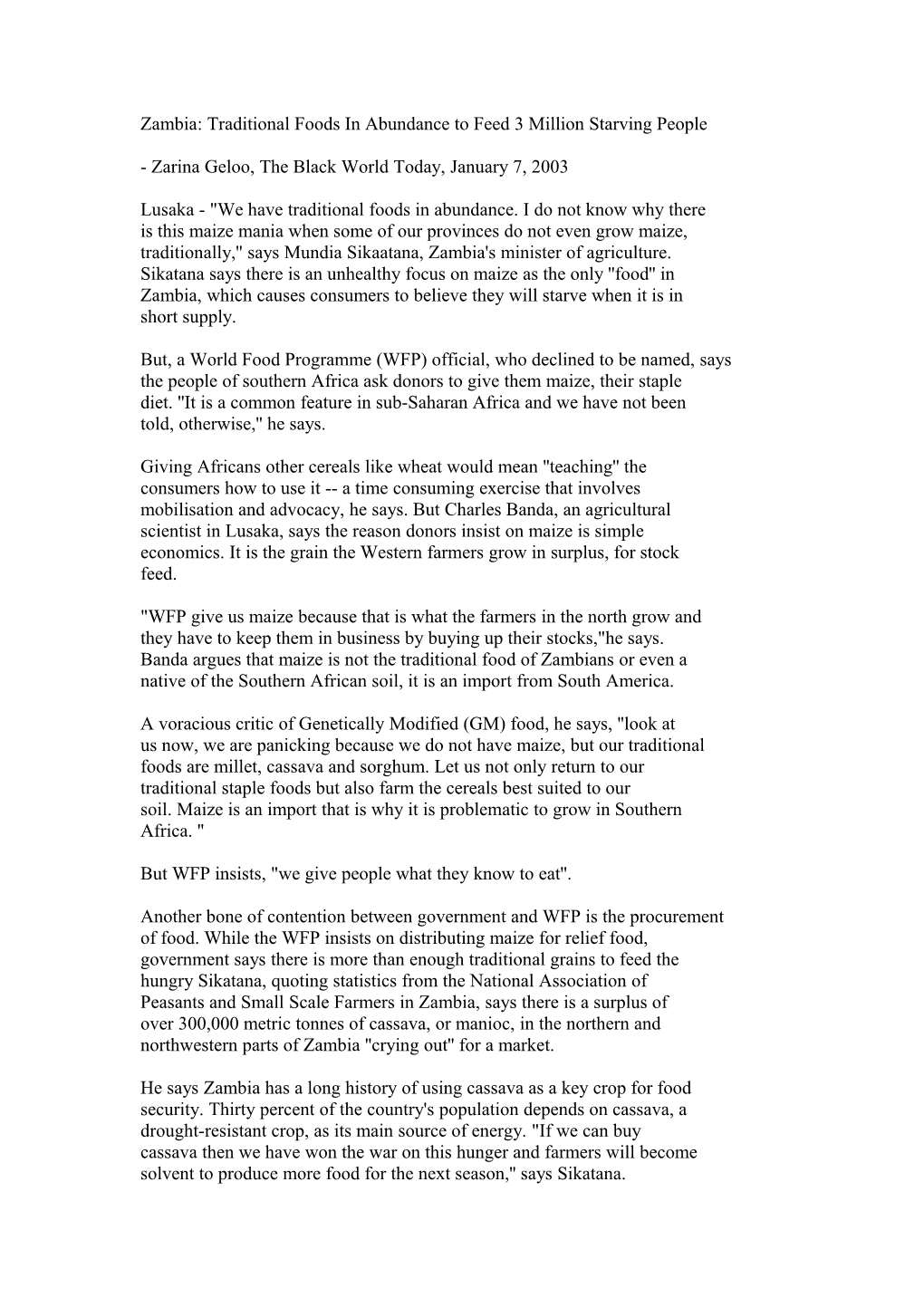Zambia: Traditional Foods In Abundance to Feed 3 Million Starving People
- Zarina Geloo, The Black World Today, January 7, 2003
Lusaka - "We have traditional foods in abundance. I do not know why there
is this maize mania when some of our provinces do not even grow maize,
traditionally,'' says Mundia Sikaatana, Zambia's minister of agriculture.
Sikatana says there is an unhealthy focus on maize as the only ''food'' in
Zambia, which causes consumers to believe they will starve when it is in
short supply.
But, a World Food Programme (WFP) official, who declined to be named, says
the people of southern Africa ask donors to give them maize, their staple
diet. ''It is a common feature in sub-Saharan Africa and we have not been
told, otherwise,'' he says.
Giving Africans other cereals like wheat would mean ''teaching'' the
consumers how to use it -- a time consuming exercise that involves
mobilisation and advocacy, he says. But Charles Banda, an agricultural
scientist in Lusaka, says the reason donors insist on maize is simple
economics. It is the grain the Western farmers grow in surplus, for stock
feed.
"WFP give us maize because that is what the farmers in the north grow and
they have to keep them in business by buying up their stocks,"he says.
Banda argues that maize is not the traditional food of Zambians or even a
native of the Southern African soil, it is an import from South America.
A voracious critic of Genetically Modified (GM) food, he says, ''look at
us now, we are panicking because we do not have maize, but our traditional
foods are millet, cassava and sorghum. Let us not only return to our
traditional staple foods but also farm the cereals best suited to our
soil. Maize is an import that is why it is problematic to grow in Southern
Africa. ''
But WFP insists, "we give people what they know to eat''.
Another bone of contention between government and WFP is the procurement
of food. While the WFP insists on distributing maize for relief food,
government says there is more than enough traditional grains to feed the
hungry Sikatana, quoting statistics from the National Association of
Peasants and Small Scale Farmers in Zambia, says there is a surplus of
over 300,000 metric tonnes of cassava, or manioc, in the northern and
northwestern parts of Zambia ''crying out'' for a market.
He says Zambia has a long history of using cassava as a key crop for food
security. Thirty percent of the country's population depends on cassava, a
drought-resistant crop, as its main source of energy. "If we can buy
cassava then we have won the war on this hunger and farmers will become
solvent to produce more food for the next season,'' says Sikatana.
WFP resident representative in Zambia, Richard Ragan told a donor meeting
in Lusaka recently that "the government has been asking us to use the
funds mobilised to buy food locally but we are constrained by our
regulations''. Sikatana says government will encourage the UN agency to
change its mind. - We have managed to convince some of our friendly donors
to stipulate as a condition, that their funds are for local procurement so
we are moving slowly,'' he says.
This has brought hard feelings, says a source in the ministry of
agriculture. WFP is the main agency in mobilising and channelling food
relief in Southern Africa. "As a ministry we are uneasy. We cannot help
but believe in the age-old trick of giving with the right hand and taking
with the left. The money given for food by the West goes back to it via
the purchase of maize from its farmers,'' says the source in the ministry
of agriculture.
According to the latest emergency report, Zambia needs 224,000 Metric
Tonnes (MT) of grain to feed its hungry population up to Mar 2003. The
World Food Programme has pledged to provide 82,000 MT, leaving a deficit
of 120,000 MT. Civil society has picked up the slack in the fast losing
battle to resolve the food crises. Working with Sikatana, the group
comprising churches and non-governmental organisation (NGOs), has formed
an alliance to raise funds to buy cassava from areas of surplus and
distribute it to the food-deficit areas.
In a petition signed by about 90 organisations, Co-ordinator of the
project, Bernadette Lubozhya requests Zambians and local organisations to
raise about 59 million U.S. dollars to buy and distribute the cassava,
while government resolves issues with World Food Programme. "We rejected
the GM food that was given to us on our own, we cannot look to the same
donor community and foreigners to do things for us, we have to take the
initiative,'' she says.
Richard Lee, WFP spokesperson in South Africa, had warned, when Zambia
rejected GM maize, that it would not only be difficult to source non-GM
food but it would also be hard to get it in time to avert hunger.
Concurring, Lubozhya presses her point home about buying food already
available in the southern African country. When Sikatana ordered WFP to
get rid of the 12,000 tonnes of GM maize in the country late last year,
only a few countries like the U.S. government had pledged 30,000 MT of
wheat and Sorghum, and Italy had donated white (non-GM) maize worth one
million U.S. dollars.
The World Bank has given Zambia 50 million U.S. dollars in grants and
loans for drought relief, but this money has already been committed to
other areas and it is unlikely any of it will be channelled to local
procurement. Zambia, along with Zimbabwe and Malawi, is the hardest hit by
a food shortage due to two successive droughts and poor agricultural and
economic policies.
Zambia: Traditional Foods in Abundance to Feed 3 Million Starving People
